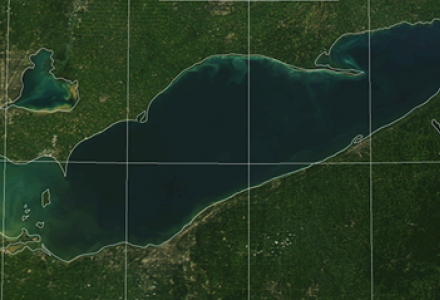
*The comment period has been extended until March 28, 2020. See https://ijc.org/en/nutrient2020
Lake Winnipeg suffers from harmful algal blooms caused by excess nutrients, and work by provincial agencies and the IJC’s own modeling suggest that a significant portion of those nutrients come from the Red River, which runs from the United States into Canada.
An IJC-funded report, in an online public comment period through Feb. 28, aims to suggest specific nutrient targets at the transboundary region of the Red that would, if accepted by the Canadian and US governments, help reduce the extent of those harmful blooms on the lake and protect the river too.
Lake Winnipeg and other lakes in the international Red River watershed experience algal blooms that negatively impact the ecology and health of the water systems.
Algal blooms can spoil drinking water, ruin beaches, reduce property values, and negatively impact fish and other aquatic life. Some algae – called blue-green algae or cyanobacteria - produce toxins that can be dangerous to people, livestock and pets. Algal blooms also have a negative effect on the economy by decreasing tourism and may reduce the productivity of commercial and recreational fisheries.
Since some of Lake Winnipeg’s tributaries (in this instance, the Red River) are partially in the United States, getting a handle on this problem requires binational cooperation.
Tracking Water Quality
The IJC’s Red River Board and its precursors have been tracking water quality at the Canada-US border since 1969 while provincial, state and federal agencies collect water quality data from numerous locations in North Dakota, Minnesota and Manitoba.
This will be the first time the board has provided suggestions on nutrient loading targets at the border, said board member Jim Ziegler, a regional manager with the Minnesota Pollution Control Agency (MPCA). The targets are upper values of how much phosphorus and nitrogen can enter the waterways from sources such as farmland and sewer systems to limit algal growth and improve water quality.
“For the international Red River basin to deal with that issue (of nutrients), we have to understand the contributions coming from different jurisdictions,” Ziegler said.

To that end, the IJC supported a study, completed in 2016, to determine nutrient targets through a $250,000 IJC’s International Watersheds Initiative (IWI). The IWI is funded jointly by the two federal governments. The study included additional financial and in-kind assistance from the US Geological Survey, Environment and Climate Change Canada, the MPCA, North Dakota Department of Health, Manitoba Sustainable Development and the Buffalo Red River Watershed District.
The study involved using water quality data collected from the two federal governments, states and the province to create a model that looked at the relationship between nutrient levels and how they affect the aquatic ecosystem within the Red River basin. The first contracts for the work were issued about seven years ago, Ziegler said, though initial discussions date back about a decade.
A peer review of the 2016 study results was finished in 2018, Ziegler said. A revised board report was sent to the IJC in December 2019 and posted on its website.
The report proposes that at the border, total phosphorus and nitrogen in the water be limited to 0.15 milligrams per liter (0.15 parts per million) and 1.15 mg/l (1.15 ppm), respectively. The loading targets – essentially how much of these nutrients can be allowed to enter the river system by the international boundary – are 1,400 tons per year for phosphorus and 9,525 tons per year for nitrogen.
A public hearing was held Jan. 16 in Fargo on the draft report, and another was held Feb. 12 in Winnipeg.
After the Feb. 28 deadline for public input, the IJC will review comments and consider any revisions to the recommended targets that may be needed before sending them to the Canadian and US governments. The IJC’s recommended targets are not binding; it’s up to the governments to decide if, when and how to implement them.

Kevin Bunch is a writer-communications specialist at the IJC’s US Section office in Washington, D.C.




